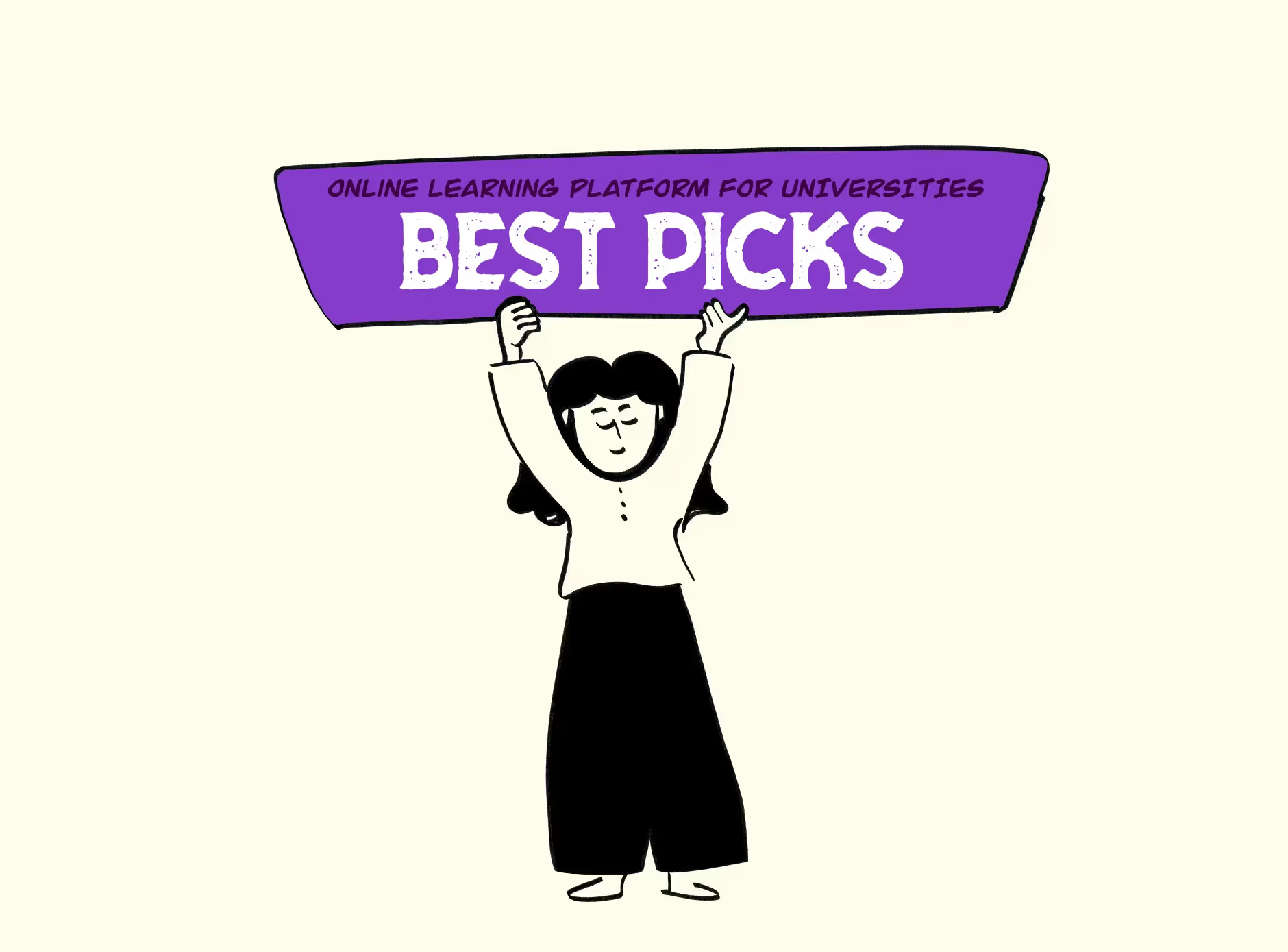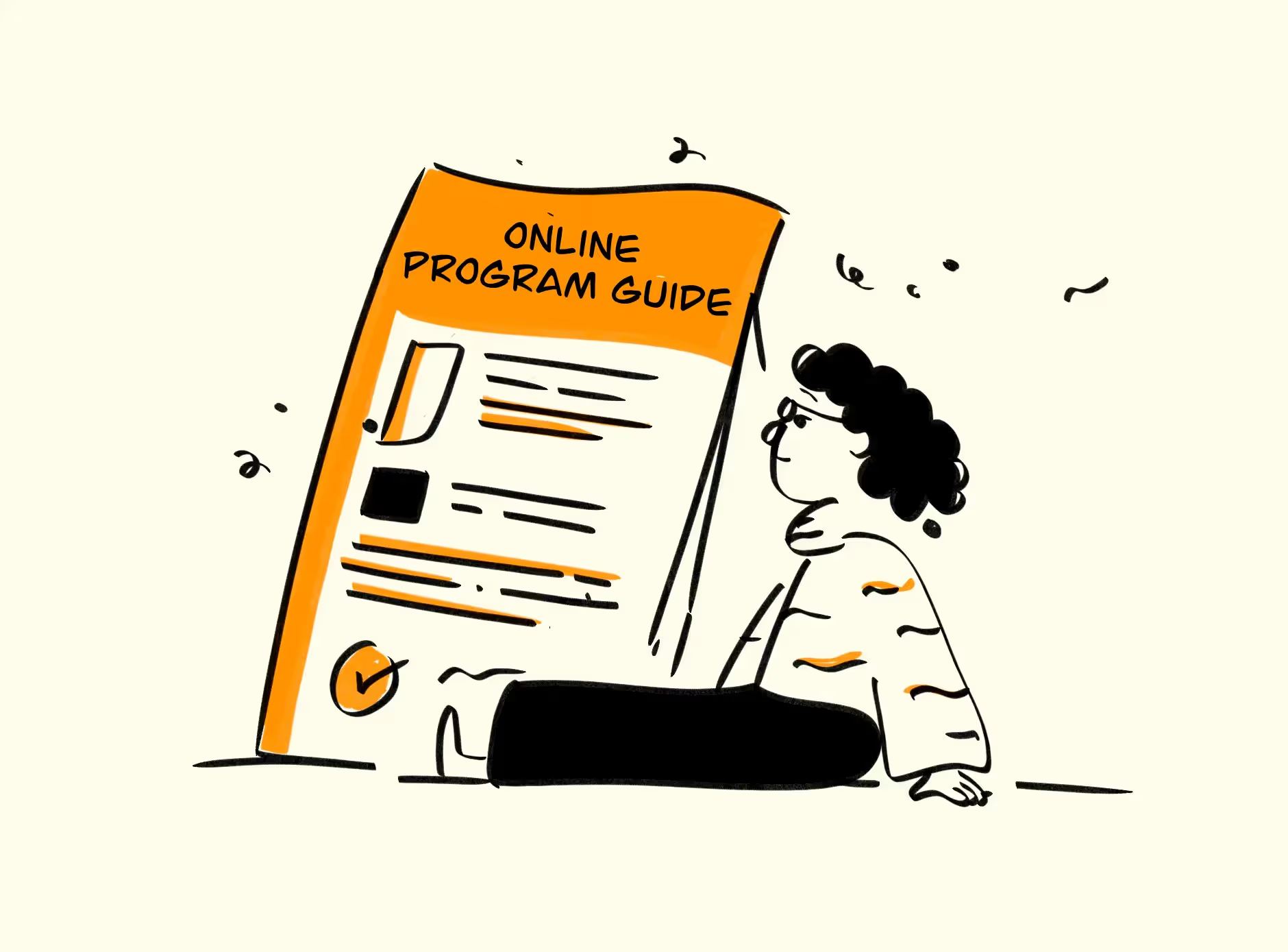


Key Takeaways
The world that we live in today loves eTeaching. The school teachers, college professors, and even the entrepreneurial teachers all appreciate the flexibility of online teaching. Forbes forecasts that the future of the EdTech market is to be expected to expand to $325 billion by the year 2025.
But as the market for EdTech increases, so will the people coming up with new and improved technologies to teach online. This further promotes competition in the market, making it necessary to stay abreast of the competition and offer audiences specific and innovative products and services. This article focuses on sharing insights on what online teaching jobs are, how online education websites function, the eTeaching Platform Design and Development Guide, Steps to Build an eTeaching Platform from Scratch, and Must-Have Features for an Educational Platform MVP, etc.
What are online teaching jobs?
There isn’t much of a difference between online teaching/eTeaching and offline teaching. The only core difference is that online teaching takes place on the internet or the virtual space as we know it, while offline teaching or traditional teaching takes place in person.
Due to the technology available to us, online teaching platforms allow teachers and students worldwide to connect and get to know each other over the internet.The widespread coronavirus in the last year or 2 (totally lost track of time) has forced all schools, colleges, and offices to shut down and work in a virtual environment. Talking about India in particular, online teaching was such a foreign concept and has caused a fair share of problems for the teachers as well as the students.
Nevertheless, teachers from all sectors of education have adopted it due to the lack of choice. Speaking of current times, teaching online in India is one of the most looked after jobs among the common people of all age groups. We have all adapted to applications like Zoom, Google meets, Skype, etc. which have given us the ability to conduct video calls/conferences for any and all purposes. Apart from these applications, many other platforms have also emerged in the market for online teaching specifically.
In fact, online teaching and learning are no longer used only for school and college degrees. Anyone anywhere can learn anything they want from the internet. Therefore, online teaching is a far more beneficial job than a regular school teacher. This is because of two reasons. First, you are not bound by the rules and regulations of any institution. You are your own boss, and you decide when you want to teach your students. Second, you can do multiple teaching jobs at a time and earn more money. This is not possible in the case of a regular teacher. You cannot switch between schools and institutions in a single day on the offline mode of teaching. But you clearly can switch between applications and software to pass your extra time more productively, all while expanding your knowledge.
How Do Online Education Websites Work?
We have seen how COVID-19 has accelerated the transition from traditional education methods to a safer virtual way. The fear and uncertainty of online education from 2020 to 2021 have drastically changed. People have adapted well to the online teaching and learning format. Most of us can now handle applications and websites without blinking an eye.
Let’s see what businesses, teachers as well as students expect from a teaching website.
From the perspective of a Business
Regardless of whether you are making a plan to fabricate an internet learning stage, or you as of now have an MVP or live schooling project, your undertaking should convey:
- Cost efficiency: Virtual schools are known to be more affordable than customary blocks and concrete grounds. There are no structures or grounds and no bills for warming, support, and so forth. Incorporate learning, and online schooling implies having a prepared labour force while saving money on disconnected classes. It likewise suggests the capacity to save money on representative and mentor travel and convenience, additional compensations, and so forth.
- Greater crowd: Easy to understand instructive sites arrive at more clients and draw in new understudies from distant areas. To grow, a business needs to extend its client base and enter new business sectors.
- Availability: This is especially effective for organisations that put resources into corporate microlearning. Such stages permit transforming day-discharge preparation into when everything looks good.
- Quality learning: Any instructive foundation is just about as great as the nature of the information it offers. Positive and helpful learning encounters help to make an asset viral and to build maintenance and proposals.
- Profit: The assortment of online stage types directs the decision of adaptation choices. In any case, where does the cash come from?
In short, there are three standard ways of adapting an internet-based instruction stage:
- Corporate membership: You can interface with colleges and organisations and welcome them to teach their understudies/representatives through your foundation, paying a membership charge for utilising the product.
- Freemium model: This model permits you to offer free courses however offers discretionary premium types of assistance: coordinated illustrations with a mentor, explicit learning materials, and paid affirmations. This model fits independent courses, as no timetable and no online classes are required.
- Publicising: Publicizing in versatile or web applications should not be irritating. Be that as it may, showing some significant crowd explicit pennants or advancing supported courses from organisations can be sensible.
From the perspective of the Student
As far as some might be concerned, a web-based site is a way to get a degree. Different students go online to foster delicate abilities, complete worker preparation, and so forth from the solace of their homes.
Thus, the web-based understudy will anticipate from an instructive site:
- Lower educational costs: Cognizance comes through correlation. Internet learning brings more practical classes and courses contrasted with independent learning.
- Adaptability: Online classes present self-guided learning, and clients can concentrate anyplace and whenever: mid-day break, having an espresso, voyaging. Such arrangements should run flawlessly on any gadget. Any spot that has an Internet association is the perfect spot.
- Online Support: Criticism is persuasive, particularly from proficient instructors. Other than moment contact with the guide during a course, visit support guarantees positive involvement in a stage.
- Progress reports: The pictured limited nature of studies triggers association. Appraisal and scoring bring pride without the tension of taking a genuine test.
- Networking: Networks are a successful method for get-together similar understudies, making contests, and expanding data maintenance. Conversations, trade of inquiries, and thoughts all add to more creative learning.
- Certification: The pride is more noteworthy when the student gets as far as possible. Printable or sent-via mail official declarations and confirmations bring the ideal sensation of self-satisfaction.
From the perspective of the Teacher
Understudies' assumptions, for example, adaptability and versatility intently relate with those of the coach. Unmistakably, virtual guides pass by the accompanying advantages:
- Overall reach: Educators are keen on fostering their portfolios and getting the news out regarding their classes; eLearning stages permit instructors to draw in greater crowds and increment their benefit.
- Content creation and distribution: Regularly, EdTech stages offer incorporated intuitive or other constructor usefulness to collect video instructional exercises and different materials without any problem.
- Numerous information monetisation choices. During this time of vulnerability, web-based learning is getting steam. As indicated by the Distance Education Enrollment Report, more than 6 million understudies are at present associated with online instruction, and virtual coaches have sought after.
- Improved digital classroom management: Online study halls bring more compelling responsibility, meaningful information, and good conversation stringing to the executives. Coaches can join network behaviour necessities and jobs of tone to build up appropriate correspondence guidelines.
ETeaching Platform Design and Development Guide
Whether or not you are new or not to EdTech site improvement, the main thing to investigate is the thing that the current eLearning behemoths offer:
- Huge loads of supportive schooling content and first-rate eLearning experience;
- Faultless, smooth, and sans bug client experience;
- Capacity to follow the learning progress immediately.
While we share point-by-point experiences on an educational website design that will shake in 2021 in this blog post, we should focus on must-have usefulness to remember for your web-based learning project. Our bits of knowledge are controlled by the sort of undertaking you may be running, the Agente group's involvement with eLearning site advancement, and the usefulness of such highest level stages as Udemy, Coursera, edX, Khan Academy, Teachable, and Udacity.
Must-Have Features for an Educational Platform MVP
Since you can see it's a good idea to make your instructive stage, how about we perceive how it tends to be utilised for an eLearning site advancement.
Work on any MVP begins from a definite elaboration of an entrepreneur's vision of the undertaking and why their item should be accessible on the market. You will start with making a rundown of the essential elements to go live. You can create an MVP prerequisites list for an EdTech project all alone, or you can demand help from your product improvement accomplice.
A choice of must-have highlights for an eLearning site MVP to browse:
- Login/information exchange
- Live video correspondence
- Video courses with playback abilities
- Client profiles
- Administrator board for virtual study halls and learning content administration
- Dashboards for progress and rating following
- Rating framework
- Informing
- Course search with a suggestions instrument
- Instalment framework with different instalment choices
- Backing of various dialects
- Notices
- Social sharing to get the message out with regards to your task via web-based media
At the revelation stage, your product advancement accomplice researches the undertaking's design and proposes the most appropriate improvement tech stack.
Consequently, the essential objective of an MVP is to gather quality client criticism, including their assumptions and any component demands. It is ideal to alpha and beta-test an MVP instead of contributing a lot of your financial plan to an item that doesn't resonate with the client and isn't sought after.
Steps to Build a Fully-Fledged eTeaching Platform from Scratch
These speedy and straightforward tasks will assist you with building an unmistakable eLearning site and track down an accomplished programming improvement accomplice to give you a hand.
Step 1. Validation of Your Idea
As the market amasses with contributions, it is essential to separate from different stages. Numerous web-based courses are famous for the sketchy, meagerly sourced courses they offer. You can venture into the business by providing a premium-level, appropriately look at studies. To guarantee this quality, you can work together with instructive establishments or huge organisations. On the other hand, you might need to consider building an LMS with AR/VR experiences that stay imaginative for the market.
Use help from business experts to approve your thought practicality.
Step 2. Targeting the Right Audience
Many courses are very conventional, and the more significant part of the quality, inside and out courses, are in English. The scope of themes inside famous stages like Udemy is confined. Discovering your crowd in neglected locales or giving thin engaged courses to a particular speciality might make you a fortune in the eLearning industry.
Step 3. Unique Content Creation
Regardless of whether you expect to make the content freely or offer other suppliers' substance, ensure it coordinates with your leading interest group and completely conforms to the arrangement.
Moreover, you can handle client strategies with your custom stage and give distributors preferable conditions over other eLearning web applications. The equivalent goes for the academic freedoms of the materials you provide. You realise that it's just you who claims the course—nobody is approved to take protected innovation that has a place with you.
Step 4. Professional Consultation
Now, it's about time to discover and contact your product improvement accomplice to examine your assumptions, thoughts, and prerequisites. This is discretionary in the event that you can cover advancement needs with in-house subject matter experts. Is it accurate to say that you intend to pick a responsive arrangement or assemble a versatile application? Or then again, do you have to join these two choices?
Here, you can examine whether you need to dispatch an MVP, regardless of whether you need to go live by emphasis or in whole. To guarantee future fruitful adaptation and perfect activity of your showcasing and outreach groups, most of the necessary usefulness should be planned ahead of time and be consistently incorporated into your undertaking. Elements like AI, expanded reality, computer-generated reality, live media streaming, microlearning, and gamification can assist with building a web-based learning stage that offers profoundly customised content and a seriously captivating client experience. These patterns bring progressed estimation of understudy accomplishments and better examination, which show how your foundation and explicit courses are doing.
Step 5. UX/UI Design
Did you realise that a decent plan decreases advancement costs? Also, the plan adds to your undertaking's income and client commitment.
Realise that UX/UI configuration is an iterative cycle that generally incorporates the accompanying stages:
- UX Audit
- UX Research
- Wireframing
- UI Prototyping
- User Testing
That is the point at which the potential front end of your undertaking is being made.
Step 6. Development
This progression is likely the greatest one; it remembers frontend and backend improvement for agreement with the mockups: The backend part is a server part of the board framework that permits the client to make and convey courses, oversee clients, store data, send notices, etc. You might require different additional items, modules, and APIs that interface the framework with outsider apparatuses.
As per Freelance, the Udemy backend, for instance, is written in Python with an in-house MVC structure that permits them to modify the framework as indicated by the changing client needs. With respect to the data set, various instructive sites use MySQL. They additionally use Cloudflare as a substance conveyance organisation and Fastly as a cloud stage to deal with the huge responsibility created by numerous clients on the site. The front-end includes a UI shown in a program permitting students, educators, and site administrators to complete their responsibilities.
Udemy's frontend, for instance, is overwhelmed by Javascript, Angular, HTML5, CSS3, and Bootstrap systems. Moreover, the chance to contemplate in a hurry is precious for current students. The least you can do is embrace clients of the web form and permit them to take advantage of a versatile variant. Clients will see the value in the chance of versatile just courses upgraded with AR, VR, or different advancements.
Step 7. Testing
Careful testing is essential for any venture. It guarantees that an answer works in the way it was planned.
Various rounds of testing frequently occur. Indeed, there are different kinds of testing, yet you can pick a fitting one for a particular undertaking:
- Unit testing,
- Integration testing,
- System testing,
- Regression testing,
- Acceptance testing, etc.
When every single stage is finished and your answer is liberated from bugs, it should be prepared for the organisation.
Step 8. Deployment
That is the objective that we sought after, i.e., the second when your undertaking goes into the creative climate. The DevOps group will utilise the CI/DI way to send your task all the more adequately.
Step 9. Support
Frequently, this progression is alluded to as upkeep and updates. In view of client input and further inside research, you can calibrate the framework and fix unforeseen issues.
Conclusion
In this article, we were able to provide you with a guide on how to create a full-fledged e-learning website. We showed you that it isn’t impossible to build an e-teaching portal from scratch and we showed you some key components of it. The last of the steps is to restructure the entire website so it looks good on mobile devices too. To sum up, if you are planning on making your own functional website, take these 9 steps seriously and make sure you avoid the mistakes we made when designing a website.
Looking for any other topic related to Online teaching and learning, check out our blogs. Also, let us know what other issues or topics you would like for us to explore.
Tutors Edge by EdisonOS
in our newsletter, curated to help tutors stay ahead!
Tutors Edge by EdisonOS
Get Exclusive test insights and updates in our newsletter, curated to help tutors stay ahead!











.png)
.webp)
